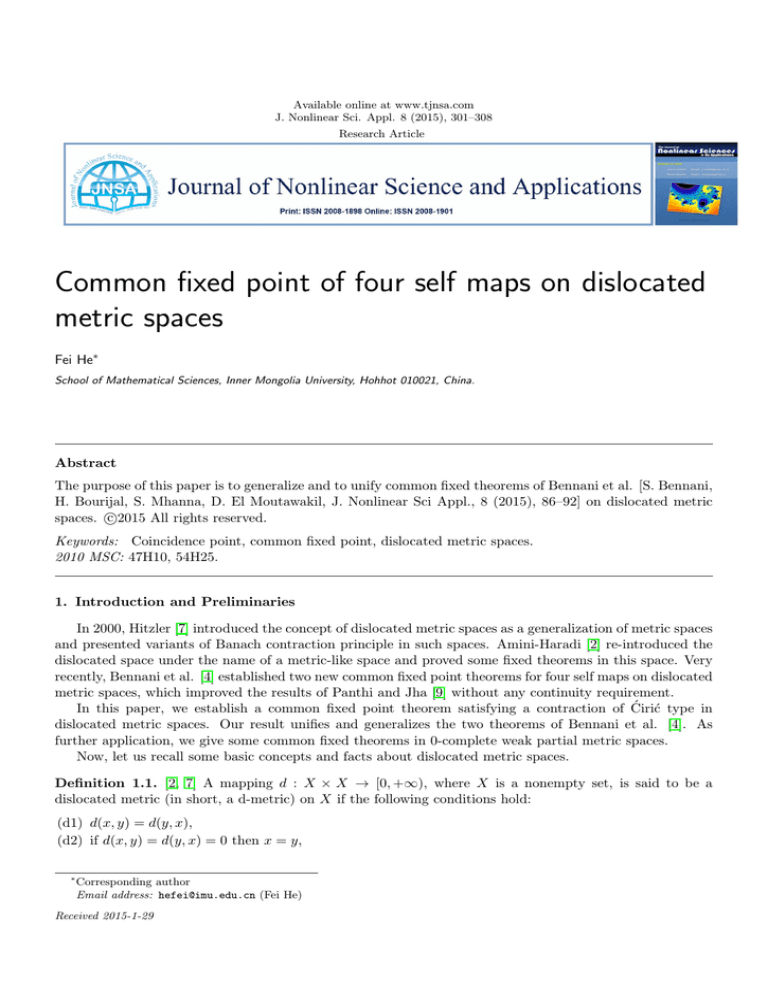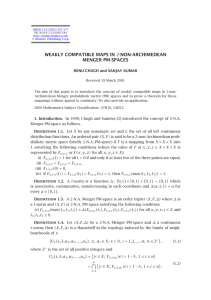
Available online at www.tjnsa.com
J. Nonlinear Sci. Appl. 8 (2015), 301–308
Research Article
Common fixed point of four self maps on dislocated
metric spaces
Fei He∗
School of Mathematical Sciences, Inner Mongolia University, Hohhot 010021, China.
Abstract
The purpose of this paper is to generalize and to unify common fixed theorems of Bennani et al. [S. Bennani,
H. Bourijal, S. Mhanna, D. El Moutawakil, J. Nonlinear Sci Appl., 8 (2015), 86–92] on dislocated metric
c
spaces. 2015
All rights reserved.
Keywords: Coincidence point, common fixed point, dislocated metric spaces.
2010 MSC: 47H10, 54H25.
1. Introduction and Preliminaries
In 2000, Hitzler [7] introduced the concept of dislocated metric spaces as a generalization of metric spaces
and presented variants of Banach contraction principle in such spaces. Amini-Haradi [2] re-introduced the
dislocated space under the name of a metric-like space and proved some fixed theorems in this space. Very
recently, Bennani et al. [4] established two new common fixed point theorems for four self maps on dislocated
metric spaces, which improved the results of Panthi and Jha [9] without any continuity requirement.
In this paper, we establish a common fixed point theorem satisfying a contraction of Ćirić type in
dislocated metric spaces. Our result unifies and generalizes the two theorems of Bennani et al. [4]. As
further application, we give some common fixed theorems in 0-complete weak partial metric spaces.
Now, let us recall some basic concepts and facts about dislocated metric spaces.
Definition 1.1. [2, 7] A mapping d : X × X → [0, +∞), where X is a nonempty set, is said to be a
dislocated metric (in short, a d-metric) on X if the following conditions hold:
(d1) d(x, y) = d(y, x),
(d2) if d(x, y) = d(y, x) = 0 then x = y,
∗
Corresponding author
Email address: hefei@imu.edu.cn (Fei He)
Received 2015-1-29
F. He, J. Nonlinear Sci. Appl. 8 (2015), 301–308
302
(d3) d(x, y) ≤ d(x, z) + d(z, y),
for all x, y, z ∈ X. The pair (X, d) is called a dislocated metric space (in short, a d-metric space).
It is clear that a d-metric space (X, d) satisfies all of the conditions of a metric except that d(x, x) may
be positive for x ∈ X.
Definition 1.2. [7] Let (X, d) be a d-metric space. Then
(1) A sequence {xn } in X converges to x ∈ X if and only if limn→+∞ d(x, xn ) = 0.
(2) A sequence {xn } in X is called a Cauchy sequence if and only if d(xn , xm ) → 0 as m, n → +∞.
(3) The space (X, d) is said to be complete if every Cauchy sequence {xn } in X converges.
Remark 1.3. [4] It can be verified that in d-metric spaces, the following statements hold.
(i)
(ii)
(iii)
(iv)
A subsequence of a Cauchy sequence is a Cauchy sequence.
A Cauchy sequence which possesses a convergent subsequence, converges.
Limits of a convergent sequence are unique.
A d-metric d is continuous, that is, {xn } converges to x and {yn } converges to y imply d(xn , yn ) →
d(x, y) as n → ∞.
Definition 1.4. Let A and S be self maps of a set X. If Ax = Sx for some x ∈ X, then x is called a
coincidence point of A and S. The pair A, S of self maps is weakly compatible if they commute at their
coincidence points.
2. Main results
Now we can state our main results.
Theorem 2.1. Let (X, d) be a d-metric space and let A, B, T and S be four self maps on X such that
T X ⊂ AX and SX ⊂ BX. Suppose that there exists a real number λ with λ ∈ [0, 21 ), satisfying for all
x, y ∈ X
d(Sx, T y) ≤ λM (x, y),
(2.1)
where
M (x, y) = max{d(Ax, T y), d(By, Sx), d(Ax, Sx), d(By, T y), 2d(Ax, By)}.
If the range of one of the mappings A, B, S and T is a complete subspace of X, then
(i) B and T have a coincidence point u,
(ii) A and S have a coincidence point v, and
(iii) Av = Sv = Bu = T u.
Moreover, if the pairs {A, S} and {B, T } are weakly compatible, then A, B, S and T have a unique common
fixed point y and d(y, y) = 0.
Proof. Let x0 be an arbitrary point in X. Since SX ⊆ BX, there exists x1 ∈ X such that Bx1 = Sx0 . Since
T X ⊂ AX, there exists x2 ∈ X such that Ax2 = T x1 . Continuing this process, we can construct sequences
{xn } and {yn } in X defined by
y2n = Sx2n = Bx2n+1 , y2n+1 = T x2n+1 = Ax2n+2 , ∀n ∈ N.
(2.2)
We claim that {yn } is a Cauchy sequence in (X, d).
First we prove that for each n ≥ 1,
d(yn , yn+1 ) ≤ δd(yn−1 , yn ),
(2.3)
F. He, J. Nonlinear Sci. Appl. 8 (2015), 301–308
303
λ
where δ = max{ 1−λ
, 2λ}.
Using (2.1), we obtain
d(y2n , y2n+1 ) = d(Sx2n , T x2n+1 ) ≤ λM (x2n , x2n+1 ),
where
M (x2n , x2n+1 )
= max{d(Ax2n , T x2n+1 ), d(Bx2n+1 , Sx2n ), d(Ax2n , Sx2n ), d(Bx2n+1 , T x2n+1 ), 2d(Ax2n , Bx2n+1 )}
= max{d(y2n−1 , y2n+1 ), d(y2n , y2n ), d(y2n−1 , y2n ), d(y2n , y2n+1 ), 2d(y2n−1 , y2n )}
≤ max{d(y2n−1 , y2n+1 ), d(y2n , y2n−1 ) + d(y2n−1 , y2n ), d(y2n−1 , y2n ), d(y2n , y2n+1 ), 2d(y2n−1 , y2n )}
= max{d(y2n−1 , y2n+1 ), 2d(y2n−1 , y2n ), d(y2n , y2n+1 )}.
Thus, we get the following three cases.
Case i. If d(y2n , y2n+1 ) ≤ λd(y2n−1 , y2n+1 ), then
d(y2n , y2n+1 ) ≤ λd(y2n−1 , y2n ) + λd(y2n , y2n+1 ).
From this , we deduce
λ
d(y2n−1 , y2n ) ≤ δd(y2n−1 , y2n ).
1−λ
Case ii. If d(y2n , y2n+1 ) ≤ λ · 2d(y2n−1 , y2n ), then
d(y2n , y2n+1 ) ≤
d(y2n , y2n+1 ) ≤ 2λd(y2n−1 , y2n ) ≤ δd(y2n−1 , y2n ).
Case iii. If d(y2n , y2n+1 ) ≤ λd(y2n , y2n+1 ), then by λ ∈ [0, 21 ) we have d(y2n , y2n+1 ) = 0 ≤ δd(y2n−1 , y2n ).
So, we have shown that d(y2n , y2n+1 ) ≤ δd(y2n−1 , y2n ) for all n ≥ 1. By similar arguments we can deduce
that d(y2n−1 , y2n ) ≤ δd(y2n−2 , y2n−1 ) for all n ≥ 1. Therefore, (2.3) holds for each n. That is , for n ≥ 1 we
have d(yn , yn+1 ) ≤ δd(yn−1 , yn ). From this, we see that for each n ≥ 1
d(yn , yn+1 ) ≤ δd(yn−1 , yn ) ≤ δ 2 d(yn−2 , yn−1 ) ≤ · · · ≤ δ n d(y0 , y1 ).
(2.4)
By the triangle inequality, for m > n we obtain
d(yn , ym ) ≤ d(yn , yn+1 ) + d(yn+1 , yn+2 ) + · · · + d(ym−1 , ym )
≤ (δ n + δ n+1 + · · · + δ m−1 )d(y0 , y1 )
δn
≤
d(y0 , y1 ).
1−δ
(2.5)
λ
Notice that δ = max{ 1−λ
, 2λ} ∈ [0, 1) because λ ∈ [0, 12 ). From (2.5), it follows that {yn } is a Cauchy sequence. According to Remark 1.3(i), {Sx2n }, {Bx2n+1 }, {T x2n+1 } and {Ax2n+2 } are also Cauchy sequence.
Now we can suppose, without loss of generality, that SX is a complete subspace of X. Then the sequence
{Sx2n } converges to some Sa such that a ∈ X. By Remark 1.3(ii), we see that {yn }, {Bx2n+1 }, {T x2n+1 }
and {Ax2n+2 } converge to Sa. Since SX ⊂ BX, there exists u ∈ X such that Sa = Bu. By the triangle
inequality, we obtain d(Bu, Bu) = d(Sa, Sa) ≤ d(Sa, yn ) + d(yn , Sa) = 2d(Sa, yn ). Since d(Sa, yn ) → 0, we
see d(Bu, Bu) = 0. We claim that d(Bu, T u) = 0. Suppose, to the contrary, that d(Bu, T u) > 0. By (d3)
and (2.1) we get
d(Bu, T u) ≤ d(Bu, Sx2n ) + d(Sx2n , T u) ≤ d(Bu, Sx2n ) + λM (x2n , u),
where
M (x2n , u) = max{d(Ax2n , T u), d(Bu, Sx2n ), d(Ax2n , Sx2n ), d(Bu, T u), 2d(Ax2n , Bu)}
= max{d(y2n−1 , T u), d(Bu, y2n ), d(y2n−1 , y2n ), d(Bu, T u), 2d(y2n−1 , Bu)}.
(2.6)
F. He, J. Nonlinear Sci. Appl. 8 (2015), 301–308
304
Letting n → ∞ in (2.6), by Remark 1.3(iv) we deduce that
d(Bu, T u) ≤ d(Bu, Bu) + λ max{d(Bu, T u), d(Bu, Bu), d(Bu, Bu), d(Bu, T u), 2d(Bu, Bu)}
1
= λd(Bu, T u) < d(Bu, T u),
2
which is a contradiction. Thus we obtain that d(Bu, T u) = 0 and Bu = T u, that is, u is a coincidence point
of B and T . So we proved (i).
Since T X ⊂ AX, there exists v ∈ X such that T u = Av. We show that Sv = Av. Indeed, using (2.1)
and d(Bu, Bu)=0, we have
d(Sv, Av) = d(Sv, T u) ≤ λM (v, u),
where
M (v, u) = max{d(Av, T u), d(Bu, Sv), d(Av, Sv), d(Bu, T u), 2d(Av, Bu)}
= max{d(Bu, Bu), d(Av, Sv), d(Av, Sv), d(Bu, Bu), 2d(Bu, Bu)}
= d(Av, Sv).
From this and λ ∈ [0, 21 ), we see that d(Sv, Av) = 0 and Sv = Av. Thus, v is a coincidence point of S and
A. So we proved (ii). Since Bu = T u, T u = Av and Av = Sv, we see that (iii) holds.
Now, we assume that the pairs {A, S} and {B, T } are weakly compatible. Then
AAv = ASv = SAv = SSv,
BBu = BT u = T Bu = T T u.
Let y = Bu = T u = Av = Sv. We show that y is a fixed point of T . From (2.1) and d(y, y) = 0, we obtain
d(y, T y) = d(Sv, T y) ≤ λM (v, y),
Where
M (v, y) = max{d(Av, T y), d(By, Sv), d(Av, Sv), d(By, T y), 2d(Av, By)}
= max{d(y, T y), d(T y, y), d(y, y), d(T y, T y), 2d(y, T y)}
= 2d(y, T y).
Since 2λ ∈ [0, 1), we have d(y, T y) = 0, which implies T y = y, that is, y is a fixed point of T . It follows that
By = BBu = T T u = T y = y, which implies that y is a fixed point of B.
On the other hand, by (2.1) we get
d(Sy, y) = d(Sy, T y) ≤ λM (y, y),
Where
M (y, y) = max{d(Ay, T y), d(By, Sy), d(Ay, Sy), d(By, T y), 2d(Ay, By)}
= max{d(Sy, y), d(y, Sy), d(Sy, Sy), d(y, y), 2d(Sy, y)}
= 2d(Sy, y).
Since 2λ ∈ [0, 1), we see d(Sy, y) = 0, which implies Sy = y, that is, y is a fixed point of S. It follows that
Ay = ASv = SAv = Sy = y, which implies that y is also a fixed point of A. Hence, we have shown that y
is a common fixed point of S, T, A and B and d(y, y) = d(y, T y) = 0.
Finally to prove the uniqueness, suppose that there exists u, v ∈ X such that Su = T u = Au = Bu = u
and Sv = T v = Av = Bv = v. By (2.1), we get
d(u, v) = d(Su, T v) ≤ M (u, v),
F. He, J. Nonlinear Sci. Appl. 8 (2015), 301–308
305
where
M (u, v) = max{d(Au, T v), d(Bv, Su), D(Au, Su), d(Bv, T v), 2d(Au, Bv)}
= max{d(u, v), d(v, u), d(u, u), d(v, v), 2d(u, v)}
= 2d(u, v).
Since 2λ ∈ [0, 1), it follows that d(u, v) = 0 and u = v.
From Theorem 2.1, we obtain the following corollary, which unifies the two theorems of Bennani [4].
Corollary 2.2. Let (X, d) be a d-metric space and let A, B, T and S be four self maps on X such that
T X ⊂ AX and SX ⊂ BX. Suppose that there exist real numbers α, β, γ with α, β, γ ≥ 0 and 2α+2β+ γ2 < 12 ,
satisfying for all x, y ∈ X
d(Sx, T y) ≤ α(d(Ax, T y) + d(By, Sx)) + β(d(Ax, Sx)) + d(By, T y)) + γd(Ax, By).
(2.7)
If the range of one of the mappings A, B, S and T is a complete subspace of X, then
(i) A and S have a coincidence point , and
(ii) B and T have a coincidence point.
Moreover, if the pairs {A, S} and {B, T } are weakly compatible, then A, B, S and T have a unique common
fixed point y and d(y, y) = 0.
Proof. Let λ = 2α + 2β + γ2 . Since α, β, γ ≥ 0 and 2α + 2β +
x, y ∈ X we see
γ
2
< 21 , we have λ ∈ [0, 12 ). Using (2.7), for all
d(Sx, T y) ≤ α(d(Ax, T y) + d(By, Sx)) + β(d(Ax, Sx)) + d(By, T y)) + γd(Ax, By)
γ
≤ (2α + 2β + )M (x, y)
2
= λM (x, y)
where M (x, y) = max{d(Ax, T y), d(By, Sx), d(Ax, Sx), d(By, T y), 2d(Ax, By)}. From Theorem 2.1, the
conclusion follows immediately.
Remark 2.3. Let α, β, γ ≥ 0. If α + β + γ < 14 , then
2α + 2β +
γ
1
1 1
1
1
= [(α + β + γ) + 3(α + β)] < · ( + 3 · ) = .
2
2
2 4
4
2
If γ > 0 and α + β + γ ≤ 14 , then α + β <
2α + 2β +
1
4
and
γ
1
1 1
1
1
= [(α + β + γ) + 3(α + β)] < · ( + 3 · ) = .
2
2
2 4
4
2
Consequently, Corollary 2.2 unifies the two theorems of Bennani et al. [4].
Using the same arguments as in Corollary 2.2, we obtain the following result.
Corollary 2.4. Let (X, d) be a d-metric space and let A, B, T and S be four self maps on X such that T X ⊂
AX and SX ⊂ BX. Suppose that there exist real numbers α1 , α2 , α3 , α4 and α5 with α1 , α2 , α3 , α4 , α5 ≥ 0
and α1 + α2 + α3 + α4 + α25 < 12 , satisfying for all x, y ∈ X
d(Sx, T y) ≤ α1 d(Ax, T y) + α2 d(By, Sx) + α3 d(Ax, Sx) + α4 d(By, T y) + α5 d(Ax, By).
If the range of one of the mappings A, B, S and T is a complete subspace of X, then
(i) A and S have a coincidence point , and
(ii) B and T have a coincidence point.
F. He, J. Nonlinear Sci. Appl. 8 (2015), 301–308
306
Moreover, if the pairs {A, S} and {B, T } are weakly compatible, then A, B, S and T have a unique common
fixed point y and d(y, y) = 0.
Putting A = B and S = T in Theorem 2.1, we obtain the following corollary.
Corollary 2.5. Let (X, d) be a d-metric space and let A and T be two self maps on X such that T X ⊂ AX.
Suppose that there exists a real number λ with λ ∈ [0, 21 ), satisfying for all x, y ∈ X
d(T x, T y) ≤ λM (x, y),
where
M (x, y) = max{d(Ax, T y), d(Ay, T x), d(Ax, T x), d(Ay, T y), 2d(Ax, Ay)}.
If AX or T X is a complete subspace of X, then A and T have a coincidence point in X. Moreover, if the
pair {A, T } is weakly compatible, then A and T have a unique common fixed point y in X and d(y, y) = 0.
Putting A = B = IX in Theorem 2.1, where IX is the identity mapping on X, we obtain the following
corollary.
Corollary 2.6. Let (X, d) be a d-metric space and let T and S be two self maps on X. Suppose that there
exists a real number λ with λ ∈ [0, 21 ), satisfying for all x, y ∈ X
d(Sx, T y) ≤ λM (x, y),
where
M (x, y) = max{d(x, T y), d(y, Sx), d(x, Sx), d(y, T y), 2d(x, y)}.
Then S and T have a unique common fixed point y in X and d(y, y) = 0.
Putting S = T = IX in Theorem 2.1, where IX is the identity mapping on X, we obtain the following
corollary.
Corollary 2.7. Let (X, d) be a complete d-metric space and let A and B be two surjective self maps on X.
Suppose that there exists a real number λ with λ ∈ [0, 21 ), satisfying for all x, y ∈ X
d(x, y) ≤ λM (x, y),
where
M (x, y) = max{d(Ax, y), d(By, x), d(Ax, x), d(By, y), 2d(Ax, By)}.
Then A and B have a unique common fixed point y in X and d(y, y) = 0.
3. Application to weak partial metric spaces
In 1992, Matthews [8] introduced the notion of partial metric space as a part of the study of denotational
semantics of dataflow networks. Further, Matthews showed that the Banach Contraction principle is valid
in partial metric spaces and can be applied in program verification. After that, many authors studied and
generalized the results of Matthews (see, for example, [1, 3, 5, 6]).
First, let us shortly recall some definitions and facts about weak partial metric spaces. For more details,
we can refer to [1, 6].
Definition 3.1. Let p : X × X → [0, +∞) be a function where X is nonempty set. If the function p
satisfies the following conditions for all x, y, z ∈ X:
(pm1) x = y if and only if p(x, x) = p(y, y) = p(x, y),
(pm2) p(x, x) 6 p(x, y),
F. He, J. Nonlinear Sci. Appl. 8 (2015), 301–308
307
(pm3) p(x, y) = p(y, x),
(pm4) p(x, y) 6 p(x, z) + p(z, y) − p(z, z),
then p is called a partial metric on X and the pair (X, p) is called a partial metric space. If the function p
satisfies (pm1), (pm3) and (pm4), then p is called a weak partial metric on X and the pair (X, p) is called
a weak partial metric space.
It is clear that the partial metric space is a weak partial metric space, but the converse may not be true;
see [6, Example 12].
Definition 3.2. [1, 6] Let (X, p) be a weak partial metric space. Then:
(i) a sequence {xn } in X converges to x ∈ X if and only if p(xn , x) → p(x, x) as n → ∞;
(ii) a sequence {xn } in X is called a Cauchy sequence if and only if limm,n→∞ p(xn , xm ) exists (and are
finite);
(iii) a sequence {xn } in X is called a 0-Cauchy sequence if and only if p(xn , xm ) → 0 as m, n → ∞;
(iv) the space (X, p) is said to be complete if every Cauchy sequence {xn } in X converges;
(v) the space (X, p) is said to be 0-complete if every 0-Cauchy sequence {xn } in X converges to a point
x ∈ X such that p(x, x) = 0.
It is not hard to see that if (X, p) be a 0-complete weak partial metric space, then (X, p) is a complete
dislocated metric space. Consequently, using Theorem 2.1 we obtain the following result.
Corollary 3.3. Let (X, p) be a weak partial metric space and let A, B, T and S be four self maps on X such
that T X ⊂ AX and SX ⊂ BX. Suppose that there exists a real number λ with λ ∈ [0, 21 ), satisfying for all
x, y ∈ X
p(Sx, T y) ≤ λM (x, y),
where
M (x, y) = max{p(Ax, T y), p(By, Sx), p(Ax, Sx), p(By, T y), 2p(Ax, By)}.
If the range of one of the mappings A, B, S and T is a complete subspace of X, then
(i) A and S have a coincidence point, and
(ii) B and T have a coincidence point.
Moreover, if the pairs {A, S} and {B, T } are weakly compatible, then A, B, S and T have a unique common
fixed point.
Acknowledgements
The author is supported by the National Natural Science Foundation of China (11471236), by Scientific
Studies of Higher Education Institution of Inner Mongolia (NJZZ13019) and by Program of Higher-level
talents of Inner Mongolia University (30105-125150, 30105-135117).
References
[1] I. Altun, G. Durmaz, Weak partial metric spaces and some fixed point results, Appl. Gen. Topol., 13 (2012),
179–191. 3, 3.2
[2] A. Amini-Harandi, Metric-like spaces, partial metric spaces and fixed points, Fixed Point Theory Appl., 2012
(2012), 10 pages. 1, 1.1
[3] H. Aydi, C. Vetro, W. Sintunavarat, P. Kumam, Coincidence and fixed points for contractions and cyclical
contractions in partial metric spaces, Fixed Point Theory Appl. 2012 (2012), 18 pages. 3
[4] S. Bennani, H. Bourijal, S. Mhanna, D. El Moutawakil, Some common fixed point theorems in dislocated metric
spaces, J. Nonlinear Sci. Appl., 8 (2015), 86–92. 1, 1.3, 2, 2.3
F. He, J. Nonlinear Sci. Appl. 8 (2015), 301–308
308
[5] Lj. Ćirić, B. Samet, H. Aydi, C. Vetro, Common fixed points of generalized contractions on partial metric spaces
and an application , Appl. Math. Comput., 218 (2011), 2398–2406. 3
[6] G. Durmaz, O. Acar, I. Altun, Some fixed point results on weak partial metric spaces, Filomat, 27 (2013), 317–326.
3, 3, 3.2
[7] P. Hitzler, A. K. Seda, Dislocated Topologies, J . Electr. Engin., 51 (2000), 3–7. 1, 1.1, 1.2
[8] S. G. Matthews, Partial metric topology, in: Proc. 8th Summer Conference on General Topology and Applications,
in: Ann. New York Acad. Sci., 728 (1994), 183–197. 3
[9] D. Panthi, K. Jha, A common fixed point of weakly compatible mappings in dislocated metric space, Kathmandu
University J. Sci., Engineering and Technology, 8 (2012), 25–30. 1





![(M.P.) Dong-A [11] MAPPINGS](http://s2.studylib.net/store/data/010441581_1-a70e3460008654b4bbba2d64e1b9ccd1-300x300.png)


